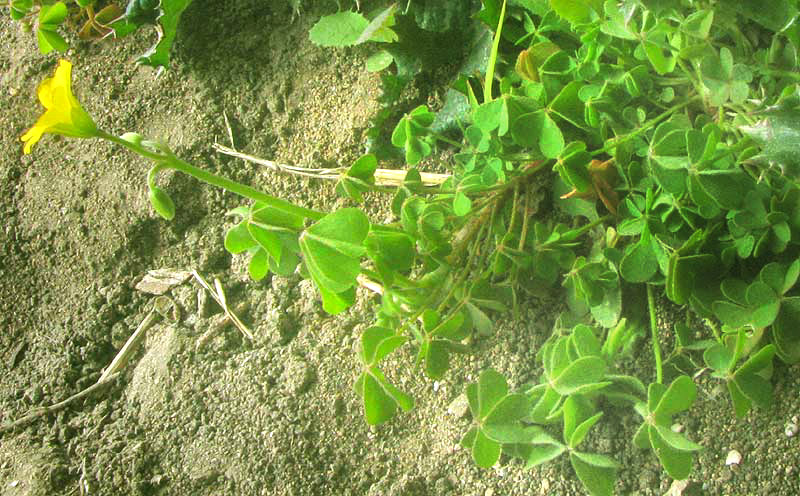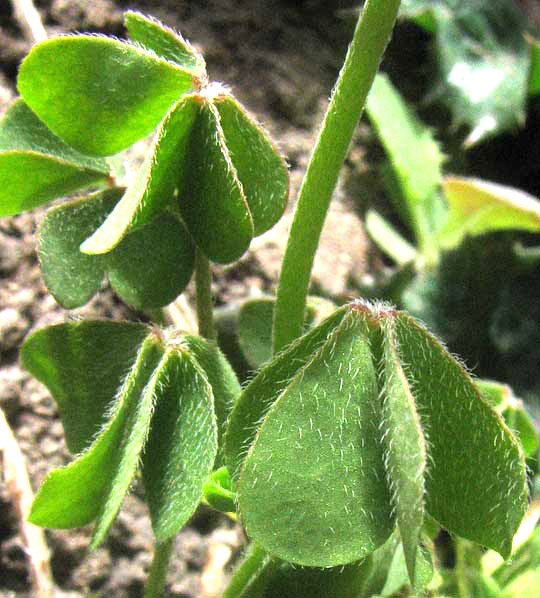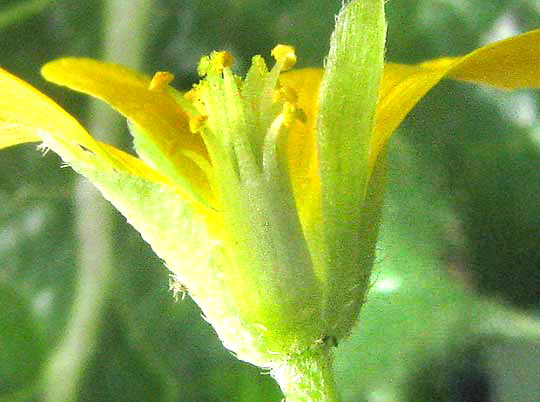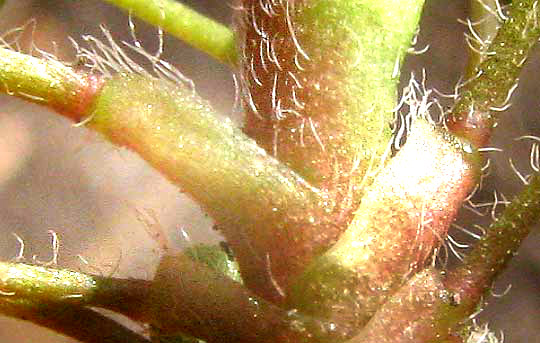Excerpts from Jim Conrad's
Naturalist Newsletter

page March 3, 2013 Newsletter issued from the valley of the Dry Frio River in northern Uvalde County, southwestern Texas, on the southern border of the Edwards Plateau; elevation ~1750m (~5750 ft); N29.62°, W99.86°; USA
CREEPING WOODSORREL FLOWERING
Though a few hundred feet lower in elevation just south of us spring is well advanced with green lawns, leafed-out trees and irises flowering, here along the Dry Frio River partway up the Edwards Plateau it's hard to find newly flowering plants. However, at the base of the sunny side of the cabin this week a certain little yellow-flowered and very welcome weed was good enough to blossom, as you can see above. A close-up of the hairy, clover-like leaves is shown below:

Anyone familiar with his or her local wildflowers knows that a herbaceous plant bearing trifoliate, clover-like leaves but regular, un-clover-like flowers that usually are yellow or pink, is one of the woodsorrels, genus Oxalis. As a group, woodsorrels are among the easiest to recognize wildflowers, but figuring out which woodsorrel you have can be a challenge, for about 800 species are recognized. The easiest way to confirm that you have a woodsorrel is to nibble a leaf, because woodsorrel leaves are very acidic. Sometimes woodsorrels are called sourgrasses, though of course they have nothing to do with the Grass Family.

Above you see features of the Oxalis flower making it an Oxalis: Five sepals and five petals, but ten stamens, five of the stamens with long filaments, five with short ones, and the stamens are joined at their filament bases into a cylinder surrounding the female pistil. Atop the pistil are five styles.
The species in the picture, OXALIS CORNICULATA, is often called Creeping Woodsorrel because its shoots tend to sprawl or creep across the ground, often rooting at the nodes. The species is so commonly found throughout the world that it's hard to say where it originated, though it's not regarded as North American.
Some literature says that Creeping Woodsorrel's leaves are tinged with reddish purple, but our plant is entirely green, and it's known that sometimes the species' leaves display no purplish at all.
In North America we have another widely distributed, very common, weedy woodsorrel species looking more or less like our Creeping Woodsorrel -- it's the Common or Yellow-flowered Woodsorrel, Oxalis stricta, a native species -- so it's good to know the secret that easily distinguishes them. Below you can see the secret proof that our cabin-side plant is the Creeping Woodsorrel:

That picture shows a part of the Creeping Woodsorrel's stem where several slender leaf petioles join the much thicker, vertical stem. Notice that at the base of each petiole there are rectangular flanges with hairs arising along their edges. These flanges are stipules, the main purpose of which usually is to protect emerging tissue until it's mature enough to withstand the elements. The nice thing is that the other very similar species, the Common Woodsorrel, doesn't have such stipules. It's a neat trick to know.
Woodsorrels are so acidy that you can pick whole plants, brew them in hot water, let the water chill, add sweetener, and you get a pretty nice drink.